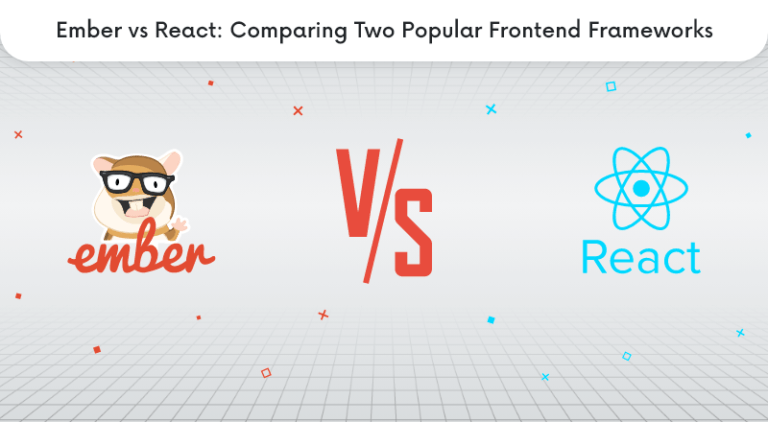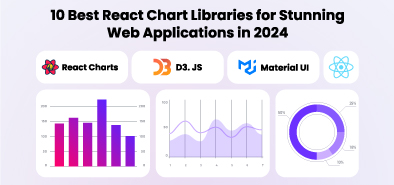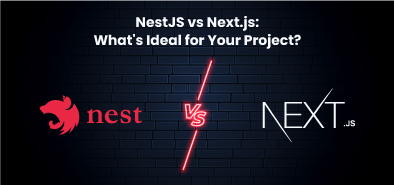Ember vs React: Comparing Two Popular Frontend Frameworks

The world is ruled by apps now and to create effective and sophisticated apps, having the best frontend framework is essential. With the need for scalability and responsiveness increasing, developers tend to go for JavaScript as their chosen language. And, when it comes to JavaScript tools, the two widely used names are React and Ember.js.
Ember.js vs React is an interesting comparison. Both are popular JavaScript frameworks that are best used for front-end development and for creating attractive user interfaces. The developer community has been highly pleased with these technologies. Before we compare them both, let us glance through them individually.
What is Ember.js?
Ember.js is an open-source JavaScript web framework, utilizing a component-service pattern. It allows developers to create scalable single-page web applications by incorporating common idioms, best practices, and patterns from other single-page-app ecosystem patterns into the framework. – Wikipedia
Ember is a free, open-source JavaScript framework for creating modern web applications. It is enriched with salient features needed to create rich user interfaces that work on any device. Developers can create client-side JavaScript applications through this comprehensive tool. It has a scalable UI architecture that follows the MVVM model based on the JavaScript web framework. Ember.js has a well-structured, stable, and robust framework that offers two-way binding and server-side rendering.
What is Ember.js Used For?
Ember.js is considered ideal for long-term projects, single-page apps, web apps that have native features, apps that need a Python-like environment, and apps that have complicated functionality integration.
Ember Features
- End-to-end reliable framework
- Client-side rendering
- Access to data from multiple sources simultaneously
- Ember CLI – generates the most accurate code
- Focus on high performance
- Fledged templating system
- Enriched default architecture
- Precise and effective documentation
- Skilled community support
- Less prone to errors
Organizations Using Ember
- Facebook
- Airbnb
- Netflix
- The New York Times
- Bloomberg
- Discord
- Skype
- Pinterest
- Uber Eats
What is React.js?
React (also known as React.js or ReactJS) is a free and open-source front-end JavaScript library for building user interfaces based on UI components. – Wikipedia
React is a powerful, cost-effective JavaScript library that is leveraged by developers to create interactive user interfaces for websites and complicated web applications that manage high-end traffic. It focuses on independent, reusable components. It has a custom syntax, JSX, because of which coding becomes less complicated. It makes use of isolated pieces of code called components, to decide what to display on the screen.
Developers can simply design views for different states in the application and React.js can render the apt components as the data changes. It can create summarized components that can handle their state and later, compile them to create complicated user interfaces.
What is React Used For?
React is used for creating server-side rendered pages, highly interactive UI, SPA, reusable components, and real-time light-weighted experiences. It is suited for apps with regular data updates. For web and mobile applications, it helps in creating a view layer or a presentation layer.
React Features
- Learn once, write anywhere
- Component-based design with Virtual DOM
- XML-life syntax extension for faster coding
- SEO friendly
- Reusable code components
- Faster rendering with the creation of isomorphic code
- Reduced development time and coding efforts
- Full application customization and flexibility
- Simple learning curve with high productivity
- Simplification of DOM manipulation
Organizations Using React
- Accenture
- LinkedIn
- Square
- Twitch
- Runtastic
- Groupon
- OYO Rooms
- TED
- Netflix
- Heroku
Ember.js vs React: A Comprehensive Comparison
There is a certain basis of comparison, depending on which organizations can take a call in choosing from Ember vs React. Here are they:
| Parameters |
Ember.js |
React |
| Overview |
A framework for creating web apps. A data library that assists in querying and caching. Ideal for novices since it lessens the burden of managing the data from the client side. Apt for dynamic SPA. Fast, comprehensive, and flexible. |
A JavaScript library to create user interfaces. A data framework that is fast in usage because of its Virtual DOM. Gels well with other peer technologies and hence is popular. Apt for huge web apps. High performance and productivity. |
| Server Rendering |
No |
Yes |
| Performance |
A tad slower as compared to React since it is huge and faces issues during rendering. |
Faster because of its view library. Uses multiple components but offers good performance. |
| Architecture |
Offers a default architecture pattern that is loved by developers. Has good distributor logic./td> |
Developers use Flux architecture since React doesn’t have any architecture of its own. |
| Learning Curve |
Longer learning curve since it goes by the convention method over configuration and hence takes longer to learn. |
The learning curve is less as there are libraries and APIs to support faster grasping and JavaScript is known to all. |
| Model of Working |
Based on the MVC model |
Based on the Virtual DOM model |
| Data Binding |
Supports two-way data binding |
Supports one-way data binding |
| Configuration or Convention |
Chooses convention over configuration. It has its router and specified actions to be followed by developers. |
Chooses configuration over convention. Offers to create a repository as you wish with high-end flexibility. |
| Template Engine |
Yes |
No |
| File and Project Structure |
A file name represents a part of the component’s code reference. Logic and templating are done in different files. |
A file name represents the complete component’s code reference. Logic and templating are done in the same file. |
| Filtering Facility |
Automated |
Not available |
| Complex Applications |
Easy management of data and server-side applications and hence suitable for complicated applications with other parameters like inbuilt components etc. |
Has a library that supports SPA and server-side rendering, hence easy to create complex applications. Creates fundamental blocks for different applications. |
| User Experience |
Possesses multiple tools that can offer the best user experience. Ember CLI assists in offering extra features. |
Possesses multiple designs that are specific for developers and hence can offer a variety of user experiences. |
| Routing and Linking |
Yes |
No |
| Security |
Offering security in Ember is easy with Cross-site Request Forgery (CSRF) tokens |
Securing React applications can best be done with appropriate tools and features. |
| CLI |
There is high-end CLI which is used heavily by the developers while development work is going on |
No official CLI since is a component drive and has the same code structure throughout the programming style |
| Size of Framework |
Ember is heavy in size with additional libraries |
React is comparatively light-weighted |
| Library Support and API Development |
The inbuilt library helps in to-and-fro communication which is needed for developing APIs |
No predefined library, developers raise communication requests |
| Utilization of JSX |
No |
Yes |
Ember js vs Reactjs: The Final Note
However much you compare Ember vs React, there are certain parameters like costing, skillsets, project deadlines, software architecture, etc. that play a vital role in selecting the JavaScript framework. It must be ascertained if the technology selected fits all the requirements of a particular project and if the team members are well acquainted with the pros and cons of the involved technologies.
Ember is considered good for those developers who are keen to execute long-term projects and standard coding styles. It is ideal for applications that need a highly scalable tool, a Python-like base, and native-like features.
Reactjs development services work best for those who need time and speed. They are recommended for lightweight apps and strong server-side rendering apps along with an attractive and interactive user interface. Usually, novices opt for React because of its shorter learning curve.
The above-detailed comparison of Ember.js vs React surely would help in choosing the apt tool; but finally, it is the organization’s call!
SPEC INDIA is your trusted partner for AI-driven software solutions, with proven expertise in digital transformation and innovative technology services. We deliver secure, reliable, and high-quality IT solutions to clients worldwide. As an ISO/IEC 27001:2022 certified company, we follow the highest standards for data security and quality. Our team applies proven project management methods, flexible engagement models, and modern infrastructure to deliver outstanding results. With skilled professionals and years of experience, we turn ideas into impactful solutions that drive business growth.






